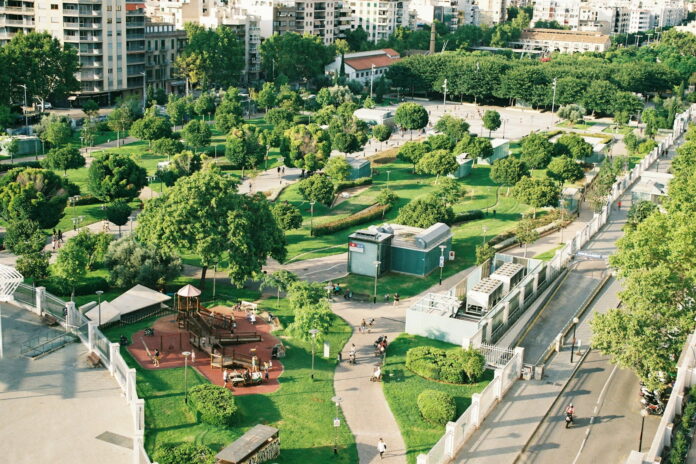The concept of ecological construction, also known as green building or sustainable construction, is a revolutionary approach in the field of architecture and construction that emphasizes environmental responsibility and resource efficiency. This approach extends from the design phase through to construction, operation, maintenance, renovation, and even demolition. The primary goal is to create structures that coexist harmoniously with the natural environment, minimize waste, reduce energy consumption, and provide healthier living spaces for occupants.
Ecological construction incorporates a variety of strategies, including the use of renewable materials, energy-efficient design elements such as natural lighting and ventilation, water-saving fixtures, and the integration of green spaces. These buildings are designed to reduce the overall impact on human health and the natural environment by efficiently using energy, water, and other resources, protecting occupant health, and reducing waste, pollution, and environmental degradation.
The rise of ecological construction reflects a growing recognition of the need to address the environmental challenges posed by traditional building practices. With the construction industry responsible for a significant portion of global energy use and carbon emissions, a shift towards sustainable building practices is not just desirable but essential for the future health of our planet.
The Health Benefits of Green Buildings: Enhancing Resident Well-being
Green buildings are designed with the health and well-being of their occupants in mind. Research has shown that residents of green buildings benefit from improved air and water quality, better lighting, and materials that are safer for human health. For instance, the use of low-emitting materials reduces the presence of volatile organic compounds (VOCs) and other toxins in the indoor environment, which can cause a range of health issues from respiratory problems to headaches.
Green buildings often incorporate design elements that promote physical activity, such as stairs that are more appealing to use than elevators, and communal areas that encourage social interaction. Access to natural light through well-placed windows and the use of daylighting techniques can also enhance mood and productivity while reducing energy costs associated with artificial lighting.
The temperature and humidity levels in green buildings are carefully managed to provide maximum comfort while using less energy. This is achieved through high-performance insulation and HVAC systems, which also contribute to a quieter indoor environment, reducing stress and improving sleep quality.
Statistics from various studies support the health benefits of green buildings. For example, a report by the World Green Building Council found that employees working in green-certified buildings reported a 26% improvement in cognition and 30% fewer sickness-related absences. These figures underscore the tangible health benefits that sustainable construction can deliver.
Living with Nature: How Ecological Construction Improves Indoor Air Quality and Reduces Toxins
One of the most significant advantages of ecological construction is the improvement of indoor air quality. Traditional building materials and practices often lead to indoor air pollution, which can be several times worse than outdoor air pollution. Green buildings address this issue by using materials that emit fewer pollutants and by incorporating ventilation systems that filter and bring in fresh air.
Plants are often integrated into green building designs, both inside and out, to further improve air quality. They naturally filter toxins and produce oxygen, enhancing the overall indoor environment. Additionally, the use of non-toxic, natural materials reduces the risk of off-gassing from paints, adhesives, and finishes.
Water quality is also a focus in green buildings, with systems in place to filter and purify water for drinking and other uses. This not only ensures the health of residents but also reduces the strain on municipal water treatment facilities.
The reduction of toxins in the living environment is particularly beneficial for vulnerable populations such as children, the elderly, and those with pre-existing health conditions. By minimizing exposure to harmful chemicals and pollutants, green buildings can play a significant role in preventing chronic diseases and improving quality of life.
Beyond Physical Health: Psychological and Social Advantages of Residing in Eco-Friendly Structures
The benefits of living in eco-friendly structures extend beyond physical health to include psychological and social well-being. Green buildings are often designed with communal spaces that foster interaction and a sense of community among residents. This can lead to stronger social networks and a feeling of belonging, which are important factors in mental health.
The incorporation of natural elements into building design, a concept known as biophilic design, has been shown to reduce stress, enhance creativity, and improve cognitive function. Views of nature, natural light, and the presence of living plants can all contribute to a more pleasant and mentally stimulating environment.
Furthermore, residents of green buildings often report a sense of pride and satisfaction from living in a space that aligns with their values of environmental stewardship and sustainability. This can lead to increased happiness and a sense of purpose.
The psychological benefits of green living are supported by research. For example, a study published in the “Journal of Environmental Psychology” found that residents with access to green spaces reported lower levels of mental distress and higher levels of well-being.
Ecological construction offers a multitude of benefits for the health and well-being of residents. By prioritizing sustainability, green buildings not only contribute to the health of the planet but also enhance the physical, mental, and social health of their occupants. As awareness of these benefits grows, ecological construction is poised to become the standard for the future of the built environment.
